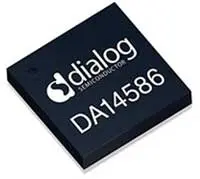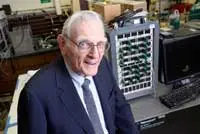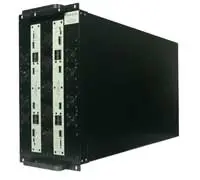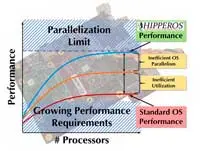Electronics News
Archive : 1 March 2017 год
 Dialog Semiconductor has launched the DA14586, said by the company to be its first standalone device qualified to support the latest Bluetooth 5.0 specification.
Dialog Semiconductor has launched the DA14586, said by the company to be its first standalone device qualified to support the latest Bluetooth 5.0 specification.
A derivative of the SmartBond DA14580, the DA14586 is said to offer greater flexibility in creating applications with small footprints and power budgets. Other enhancements include a power management setup with buck and boost converters, providing support for most primary batteries.
“Bluetooth 5 is one of the most highly-anticipated developments in connectivity and Dialog is amongst the first out of the gate … with a qualified standalone SoC,” said Sean McGrath, Dialog’s general manager, connectivity. “Not only is DA14586 following in the SmartBond tradition of flexibility and low power consumption, but now, with Bluetooth 5 support and an integrated microphone interface, we also have an SoC that opens the door to a new era of connected devices and applications.”
In addition to Bluetooth 5 support, DA14586 has twice the application memory of its predecessor and an integrated microphone interface. Dialog says the device also supports mesh based networking.
Dialog is also making available the DA14585, which features a one time programmable memory, instead of the flash memory found in the 14586.
Author
Graham Pitcher
Source: www.newelectronics.co.uk
 Engineers at the University of Texas at Austin – led by 94 year-old Professor John Goodenough, pictured, co-inventor of the lithium-ion battery – have developed solid state battery cells which they say could lead to safer, faster-charging, longer-lasting rechargeable batteries.
Engineers at the University of Texas at Austin – led by 94 year-old Professor John Goodenough, pictured, co-inventor of the lithium-ion battery – have developed solid state battery cells which they say could lead to safer, faster-charging, longer-lasting rechargeable batteries.
“Cost, safety, energy density, rates of charge and discharge and cycle life are critical for battery-driven cars to be more widely adopted,” said Prof Goodenough. “We believe our discovery solves many of the problems that are inherent in today’s batteries.”
The researchers say they have demonstrated that their new battery cells have at least three times the energy density of current lithium-ion batteries. The UT Austin battery formulation is also said to support more charging and discharging cycles, as well as recharging in minutes, rather than hours.
Instead of the liquid electrolytes used in current batteries, the researchers have developed glass electrolytes that enable the use of an alkali-metal anode and it is this development that allows energy density and cycle life to be increased.
The solid glass electrolytes also demonstrate high conductivity at -20°C, leading the team to claim their battery is the first solid state device that can operate at temperatures of less than 60°C.
Prof Goodenough and senior research fellow Maria Helena Braga are continuing their battery-related research and hope to work with battery makers to develop and test their new materials in electric vehicles and energy storage devices.
Author
Graham Pitcher
Source: www.newelectronics.co.uk
 A research team from Rice University has modelled a nanoscale sandwich in which two slices of graphene surround nanoclusters of magnesium oxide. According to the team, the sandwich should result in a ‘super strong conductive material’ with expanded optoelectronic properties.
A research team from Rice University has modelled a nanoscale sandwich in which two slices of graphene surround nanoclusters of magnesium oxide. According to the team, the sandwich should result in a ‘super strong conductive material’ with expanded optoelectronic properties.
Rice materials scientist Rouzbeh Shahsavari and his colleagues built computer simulations of the compound and found it would offer features suitable for molecular sensing, amongst other applications. The work could help researchers design a range of customisable hybrids of 2D and 3D structures with encapsulated molecules, Shahsavari said.
While graphene has no band gap, the hybrid does and the team says this band gap could be tunable, depending on the components. Optical properties may also tunable.
"We saw that while this single flake of magnesium oxide absorbed one kind of light emission, when it was trapped between two layers of graphene, it absorbed a wide spectrum,” Shahsavari noted. “That could be an important mechanism for sensors.”
Shahsavari believes the theory could be applicable to other 2D materials, like hexagonal boron nitride. “There is no single material that can solve all the technical problems of the world,” he said. “It always comes down to making hybrid materials to synergise the best features of multiple components to do a specific job. My group is working on these hybrid materials by tweaking their components and structures to meet new challenges.”
Author
Graham Pitcher
Source: www.newelectronics.co.uk
 Cadence has launched Protium S1, an FPGA based prototyping platform said to incorporates innovative implementation algorithms to boost engineering productivity.
Cadence has launched Protium S1, an FPGA based prototyping platform said to incorporates innovative implementation algorithms to boost engineering productivity.
Using Xilinx Virtex UltraScale FPGAs, the platform is said to have six times the design capacity and twice the performance of previous platforms.
According to the company, benefits of Protium S1 include: ‘ultra fast’ prototype bring up; ease of use and adoption; and innovative software debug capabilities.
“The rising need for early software development with reduced overall project schedules has been the key driver for the delivery of more advanced emulation and FPGA-based prototyping platforms,” said Dr Anirudh Devgan, general manager of Cadence’s Digital and Signoff Group and its System and Verification Group. “The Protium S1 platform offers software development teams the required hardware and software components, a fully integrated implementation flow with fast bring-up and advanced debug capabilities so they can deliver the most compelling end products, months earlier.”
When used as a front end for Cadence’s Palladium Z1 emulator, engineers can expect to bring up designs 80% more quickly than typical FPGA prototyping approaches.
Author
Graham Pitcher
Source: www.newelectronics.co.uk
 Embedded developer Hipperos has upgraded its real time operating system with new features, including hardware acceleration, fast multicore IPC and mixed criticality scheduling. The new features – said to make the RTOS suitable for use in such applications as drone navigation, medical imaging and ADAS – are included in version 17.02, which is available immediately.
Embedded developer Hipperos has upgraded its real time operating system with new features, including hardware acceleration, fast multicore IPC and mixed criticality scheduling. The new features – said to make the RTOS suitable for use in such applications as drone navigation, medical imaging and ADAS – are included in version 17.02, which is available immediately.
“Most currently available RTOSs in the market were not originally designed for multicores,” said Ben Rodriguez, the company’s CEO/CTO. “With the announcement of v17.02, we are introducing innovative features that will ensure it continues to fill the multicore performance gap.”
According to the company, its RTOS is a family of configurable, modular and parallel real-time operating systems designed specifically for multicore platforms for the next generation of reliable, low power, hard real-time, high performance embedded systems. HIPPEROS’ modularity and configurability enables different kernels to be tailored to satisfy specific application requirements, adapting to different use cases. Its low footprint hard real-time kernel enables the smooth co-ordination of a mix of software and hardware tasks without missing a single deadline.
Hipperos says a high video frame rate is key for many computer vision applications and RTOS hardware acceleration means tasks can be handled by an FPGA and video rates of 90frame/s achieved. Fast multicore IPC, meanwhile, enables tasks running on different processors to exchange data by message passing. Finally, mixed criticality scheduling allows high and low criticality tasks to run on the same board, with the RTOS taking care of priorities.
Author
Graham Pitcher
Source: www.newelectronics.co.uk

